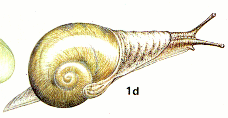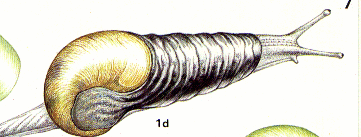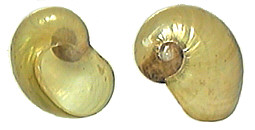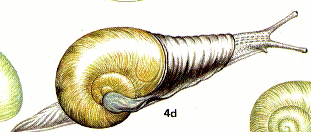Vitrina limpida Gould,1850 Shell small,6 mm,with 2.5-3 whorls,glossy,transparent,thin and fragile. It is without colour or pale greenish,it's too small for the whole body to withdrawn into. The head,neck and tentacles of the animal are pale,tan,brown.The sides of the foot and back part of the body are colorless.Around the pneumostome a dark pigmented area. Individuals probably don't live for longer than a year. In Maine to Pennsylvania and west to Minnesota,North-America.
Vitrina pellucida Müller,1774
Pellucid Snail
Shell is thin,transparent and glossy,a pale green,4,5 mm high -6 mm wide.
It has 3-3,5 whorls,is very thin and glossy.
The animal is pale grey with a darker head and tentacles.
It breeds and matures in winter and dies within a year.
Eurasia and North-America in woods,grasslands,between rocks and in dunes.
In The Alps up to 3100 mtrs.

Vitrinobrachum breve Ferussac,1821
Shell is pale green and transparent,5 mm high-5.5 mm wide.1,75 whorl.
The animal is dark grey or black.
In Western Central-Europe in parks and along rivers.

Semilimax semilimax Ferussac,1802 Shell glossy,very thin,pale translucent green,4-5 mm with 1.75 whorls.The last whorl is very expanded giving it an ear like shape. The body of the animal is 12-15 mm,dark grey on top,paler below. In The Pyrenees,Alps and Jura,widely spread but local in South- and Central Germany.In woods,under stones and leaf litter.
Semilimax kotulae Westerlund,1883 Shell is similar to S.semilimax but flatter and glossier,4.3-6 mm. Body also similar to S.semilimax. In South and SE Germany(Montane)and South-Switzerland.Living in woods under stones and litter,a montane species(up to 2200 mtrs in Switzerland).
Semilimax pyrenaicus Ferussac,1821 Shell similar to S.semilimax but the spire is almost flattened,the last whorl less expanded,5-6 mm. Body pale grey,mantle black spotted. In the French Pyrenees(Ariege to the Atlantic),Ireland(locally from Kerry to Antrim). Living in moist shady places in woods and between rocks.
Eucobresia diaphana Draparnaud,1805
Shell very thin,transparent pale green,6 mm high and 6.5 mm wide.It has 2,5 whorls.
The animal is dark grey.
South- and Central Germany,South-Holland,the Alps,Jura,Vosges and Ardennes in woods,under plants,especially in mountains up to 2800 mtrs.

Eucobresia nivalis Dumont & Mortillet,1852
Shell similar to E.diaphana but more globular,compact,5.5-6 mm.
The body is dark grey,but mantle lobe smaller.
In the French and Swiss Alps,a few localities in South-Germany and in East-Germany.
This species lives in rubbly slopes and grassy places above the tree-line at the
edges of snowfields,sometimes in damp woods.(up to 3100 mtrs in the Alps)
 © Microscopy UK and David Walker
© Microscopy UK and David Walker
Eucobresia pegorarii Pollonera,1884 Shell very glossy and thin,pale green,last whorl more expanded than E.nivalis,more compressed,6 mm.Body dark grey,the mantle has a fingerlike projection pointing backwards. In the Swiss Alps in moist grasslands and under stones,mostly above the tree-line.
Phenacolimax annularis Studer,1820 Shell globular,pale greenish with 3 whorls and deep sutures,4-5 mm. The body is dark grey with hardly a mantle lobe. Central Pyrenean,French and Swiss Alps,SW Bavaria in grassland and among stones. (attaining 2600 mtr in Switzerland).
Phenacolimax glacialis Forbes,1837 Shell similar to E.pegorarii,4.5-6 mm. Mantle large,black mantle lobe covers the shellspire. In the French,Swiss and South-German Alps among rocks and plants(attaining 2900 mtr in Switzerland)
Phenacolimax major Ferussac,1807
Shell is pale green,fragile and transparent,5 mm high-6 mm wide.2,5-3 whorls.
The animal is dark or dark-grey.
West-Europe in damp sheltered places in woods,grasslands and between rocks.

Pristiloma arcticum Lehnert Shell globose depressed,glossy,tawny brown,with minute striae Height 1.5 mm and width 2 mm. In Alaska and Washington
Pristiloma lansingi Bland Shell orbicular depressed,shiny,dark horn in color. Height 1.5 mm and width 2.5 mm with 5.5 whorls. In BC,WA,OR,CA
Pristiloma johnsoni Dall Shell small,depressed,translucent,whitish and smooth,aperture semi lunar. Height 1.05 mm and width 2.3 mm with 3.75 whorls. In WA,OR,BC.
Sub-family Vitreinae Vitrea subrimata Reinhardt,1871 Shell is thin,transparent and colorless,2.5 mm high -3 mm wide. In the Alps and South-Europe on rocky slopes,woodlands especially in the mountains.
Vitrea crystallina Müller,1774
Shell transparent,colorless or greenish,3-4 mm wide.4,5-5 whorls.
In Europe on damp places like swamps.

Vitrea contracta Westerlund,1871 The shell is transparent and colorless,2.5 mm wide. Western Eurasia and North-Africa on rocky slopes,in dunes and woodlands.
Aegopsis verticillus Ferussac,1822 The shell is yellow-brown or brown,26-30 mm wide.With 6-6,5 whorls. It has a wide and open umbilicus. Eastern Alps and Yugoslavia in damp woodlands.Up to 2200 mtrs.